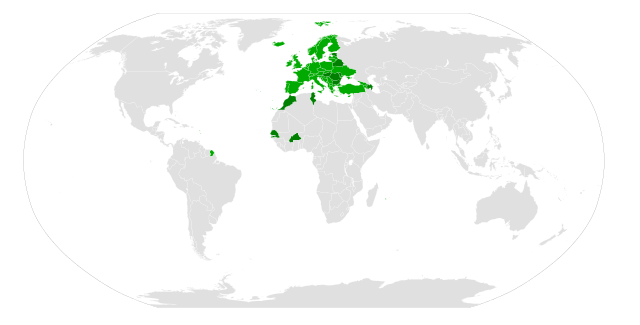Top Qs
Timeline
Chat
Perspective
Berne Convention on the Conservation of European Wildlife and Natural Habitats
1979 environmental treaty From Wikipedia, the free encyclopedia
Remove ads
The Bern Convention on the Conservation of European Wildlife and Natural Habitats, also known as the Bern Convention (or Berne Convention), is a binding international legal instrument in the field of Nature Conservation, it covers the natural heritage in Europe, as well as in some African countries. The Convention was open for signature on 19 September 1979 and came into force on 1 June 1982. It is particularly concerned about protecting natural habitats and endangered species, including migratory species.
Remove ads
Aims and objectives
The convention has three main aims, which are stated in Article 1:[1]
- to conserve wild flora and fauna and their natural habitats
- to promote cooperation between states
- to give particular attention to endangered and vulnerable species including endangered and vulnerable migratory species
Structure
Summarize
Perspective
The convention is divided into:
- Preamble
- Because this convention has a special nature, which is to include the maximum number of signatures possible, it included the eventual signing by non-members of the Council of Europe: "the member States of the Council of Europe and the other signatories hereto, Considering that the aim of the Council of Europe is to achieve a greater unity between its members,..."[1]
- Chapter I – General provisions
- This chapter contains three articles, where it is stated the three aims of the Convention and general obligations of the Contracting Parties.
- Chapter II – Protection of habitats
- Here are set out the obligations of the Contracting Parties concerning the conservation of the habitats.
- Chapter III – Protection of species
- This chapter contains the obligations of the Contracting Parties regarding the Appendices I, II, III and IV and the exceptions of these obligations.
- Chapter IV – Special provisions for migratory species
- This chapter contains the obligations of the Contracting Parties regarding migratory species.
- Chapter V – Supplementary provisions
- This chapter contains supplementary obligations of the Contracting Parties, concerning co-operation, research, reintroduction and introduction of species.
- Chapter VI – Standing Committee
- This chapter settles the functioning procedure of the Standing Committee and their tasks.
- Chapter VII – Amendments
- This chapter contains the procedure of amendments regarding articles and Appendices of the Convention.
- Chapter VIII – Settlement of disputes
- This chapter contains the procedure of the arbitration of any disputes that could arise between Contracting Parties.
- Chapter IX – Final provisions
- This chapter contains the final arrangements of the Convention.
- Appendices
- Four appendices set out particular species for protection. They are regularly updated by the Standing Committee, who are advised by a number of Expert Groups:
- Appendix I – Strictly protected flora species
- Appendix II – Strictly protected fauna species
- Appendix III – Protected fauna species
- Appendix IV – Prohibited means and methods of killing, capture and other exploitation
Remove ads
Ratifying states
Summarize
Perspective

Signed and ratified
Acceded or succeeded
Only signed
Not signed (CoE member states)
Not signed (non-CoE member states)
Member States of the Council of Europe, status as of 15 February 2022.[2]
States not members of the Council of Europe
International Organisations
Algeria, Cape Verde, the Holy See, San Marino and Russia are among non-signatories that have observer status at meetings of the committee.[citation needed]
The convention led to the creation in 1998 of the Emerald network of Areas of Special Conservation Interest (ASCIs) throughout the territory of the parties to the convention, which operates alongside the European Union's Natura 2000[3] programme.
Duties of contracting parties
All countries that have signed the convention must:[1]
- promote national conservation policies
- promote measures against pollution
- promote educational and informative measures
- co-ordinate efforts to protect migratory species
- establish legislative and administrative measures
Remove ads
Monitoring the implementation of the convention
To achieve successfully the aims of this Convention, a number of monitoring devices were implemented.
Reporting system
- Compulsory biannual reports
- Voluntary general reports (every four years)
- Legal reports (one country per year)
- National reports
- Follow-up of recommendations[4]
Groups of experts
The chosen experts are in charge of monitoring the implementation of the Standing Committee recommendation regarding species and habitats, as well as doing their own recommendations about specific conservation problems.[4]
Case-file system
The system is based in complaints for possible non-compliance or other problems related with the provisions of the Convention. These complaints are processed by the Secretariat, the Bureau and the Standing Committee and when they feel there is the need for further information, on-the-spot visits by independent experts can be arranged.[5]
Remove ads
See also
- Animal rights by country or territory
- Biogeographic regions of Europe
- Environmental agreements
- International Convention on the Protection of Birds
- International Union for Conservation of Nature
- List of international animal welfare conventions
- Migratory Bird Treaty
- Red Data Book of the Russian Federation
- List of Council of Europe treaties
References
External links
Wikiwand - on
Seamless Wikipedia browsing. On steroids.
Remove ads

